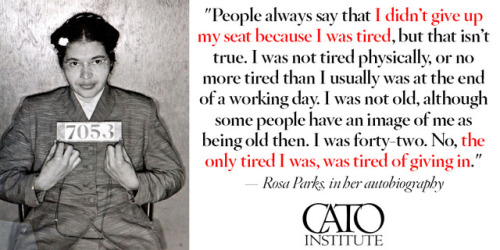#catoinstitute
If your libertarian love cares more about free markets than flowers, share these valentines with them to say “We go together like liberty and freedom.” ❤️

It’s not just love that the wall can’t stop! The wall simply won’t work.

What better pairing could there be? In the libertarian view, voluntary agreement is the gold standard of ALL human relationships, not just romantic ones.

Keeping that paramour of yours a secret? Not from the NSA! Go ahead and hide behind that heart; there won’t be much privacy for you.
Fear and mass surveillance are a constitutionally toxic political cocktail.

…unlike the federal budget.
Unfortunately,budget deficits are only getting bigger under President Trump.

The federal budget deficit was $779 billion in fiscal year 2018.
Here’s why federal debt is damaging…

Cryptocurrencies and blockchain technologies, like Bitcoin, are revolutionizing the way we think about government currency monopolies, transferring money across the globe, maintaining financial privacy and security, and verifying ownership of money or potentially everything.

Married 68 years, free market economists Rose and Milton Friedman (recipient of the 1976 Nobel Prize for Economic Science) were not just skilled economists who cared about kids, they were a charming couple who will long be remembered.
Happy Birthday to Rosa Parks, born 106 years ago today, on February 4, 1913.
Sometimes all it takes is one person or a few people saying, “We’re not going” to light the spark of a movement or a revolution, writes @CatoInstitute EVP David Boaz.
Post link

The U.S. government’s current strategy of trying to restrict the supply of opioids for nonmedical uses is not working. While government efforts to reduce the supply of opioids for nonmedical use have reduced the volume of both legally manufactured prescription opioids and opioid prescriptions, deaths from opioid overdoses are nevertheless accelerating. Research shows the increase is due in part to substitution of illegal heroin for now harder-to-get prescription opioids. Attempting to reduce overdose deaths by doubling down on this approach will not produce better results.
Policymakers can reduce overdose deaths and other harms stemming from nonmedical use of opioids and other dangerous drugs by switching to a policy of “harm reduction” strategies. Harm reduction has a success record that prohibition cannot match. It involves a range of public health options. These strategies would include medication-assisted treatment, needle-exchange programs, safe injection sites, heroin-assisted treatment, deregulation of naloxone, and the decriminalization of marijuana.
Though critics have dismissed these strategies as surrendering to addiction, jurisdictions that have attempted them have found that harm reduction strategies significantly reduce overdose deaths, the spread of infectious diseases, and even the nonmedical use of dangerous drugs.

Over the last 200 years, economic progress has helped to bring about both dramatically better standards of living and the extension of individual dignity to women in the developed world. Today the same story of market-driven empowerment is repeating itself in developing countries.
Competitive markets empower women in at least two interrelated ways. First, market-driven technological and scientific innovations disproportionately benefit women. Timesaving household devices, for example, help women in particular because they typically perform the majority of housework. Healthcare advances reduce maternal and infant mortality rates, allowing for smaller family sizes and expansion of women’s life options. Second, labor market participation offers women economic independence and increased bargaining power in society. Factory work, despite its poor reputation, has proven particularly important in that regard.
In these ways, markets heighten women’s material standard of living and foster cultural change. Markets promote individual empowerment, reducing sexism and other forms of collective prejudice.
Women’s empowerment in many developing countries is in its early phases, but the right policies can set women everywhere on a path toward the same prosperity and freedom enjoyed by women in today’s advanced countries.

AlthoughPresident Trump cites drugs passing over the U.S.’s southern border as a major justification for erecting a border wall, new data shows that, since the legalization of marijuana, drug flow over the border has substantially decreased and fewer drugs are entering where a border wall would matter.
Because it is difficult to conceal, marijuana is the main drug transported between ports of entry where a border wall would matter. However, Border Patrol seizure figures demonstrate that marijuana flows have fallen continuously since 2014, when states began to legalize marijuana. After decades of no progress in reducing marijuana smuggling, the average Border Patrol agent between ports of entry confiscated 78% less marijuana in fiscal year (FY) 2018 than in FY 2013.
As a result, the value of all drugs seized by the average agent has fallen by 70% since FY 2013. Without marijuana coming in between ports of entry, drug smuggling activity now primarily occurs at ports of entry, where a border wall would have no effect. In FY 2018, the average inspector at ports of entry made drug seizures that were three times more valuable overall than those made by Border Patrol agents between ports of entry — a radical change from 2013 when Border Patrol agents averaged more valuable seizures. This is because smugglers bring mainly hard drugs through ports. By weight, the average port inspector seized 8 times more cocaine, 17 times more fentanyl, 23 times more methamphetamine, and 36 times more heroin than the average Border Patrol agent seized at the physical border in early 2018.
Given these trends, a border wall or more Border Patrol agents to stop drugs between ports of entry makes little sense. State marijuana legalization starting in 2014 did more to reduce marijuana smuggling than the doubling of Border Patrol agents or the construction of hundreds of miles of border fencing did from 2003 to 2009.
As more states — particularly on the East Coast — legalize marijuana in 2019, these trends will only accelerate. The administration should avoid endangering this success and not prosecute state-legal sellers of marijuana. This success also provides a model for addressing illegal immigration. Just as legalization has reduced the incentives to smuggle marijuana illegally, greater legal migration opportunities undercut the incentive to enter illegally. Congress should recognize marijuana legalization’s success and replicate it for immigration.

The new Cato 2018 Paid Leave Survey of 1,700 adults finds that nearly three-fourths (74%) of Americans support a new federal government program to provide 12 weeks of paid leave to new parents or to people to deal with their own or a family member’s serious medical condition. A quarter (25%) oppose establishing a federal paid leave program. Support slips and consensus fractures for a federal paid leave program, however, after costs are considered.
The survey found 54% of Americans would be willing to pay $200 a year in higher taxes, a low-end estimate for a 12-week federal paid leave program. However, majorities of Americans would oppose establishing a federal paid leave program if it cost them $450 a year in higher taxes (52% opposed) or $1,200 a year in higher taxes (56% opposed), the mid-range and high-range cost estimates respectively.
These low-, mid-, and high-range cost estimates are based on the most high-profile federal paid leave program proposed to date: The Family and Medical Insurance Leave Act (FAMILY Act).
The survey also did not ask questions about what paid leave policies Americans would like to see offered at private companies. Instead, the Cato 2018 Paid Leave Survey focuses on what people think about establishing a government-provided paid family leave program at the federal level.

Today, on Human Rights Day, the @CatoInstitute is pleased to release the fourth annual Human Freedom Index (HFI),the most comprehensive measure of freedom ever created for a large number of countries around the globe.
The report measures a broad array of personal, civil and economic freedoms around the world and the extent to which basic rights are protected or violated. The HFI captures the degree to which people are free to enjoy important rights such as freedom of speech, religion, association, and assembly, and also measures freedom of movement, women’s freedoms, crime and violence, and legal discrimination against same-sex relationships.
Because freedom is inherently valuable and plays a role in human progress, it is worth measuring carefully. The Human Freedom Index, co-published by the Cato Institute, the Fraser Institute in Canada, and the Liberales Institut at the Friedrich Naumann Foundation for Freedom in Germany, ranks 162 countries based on 79 distinct indicators of personal, civil, and economic freedom, using data from 2008 to 2016, the most recent year for which sufficient data are available. The index is a resource that can help to more objectively observe relationships between freedom and other social and economic phenomena, as well as the ways in which the various dimensions of freedom interact with one another.
New Zealand and Switzerland are the two freest countries on this year’s index, while Venezuela and Syria rank last. The United States ranks 17, notably below its best index ranking. In 2008, the U.S. ranked 11, then fell notably until 2013, after which it rose through 2016, the latest year for which the index gathers sufficient data that is comparable globally.
Unfortunately, more countries than not have seen their level of freedom decline, compared to 2008 or to last year’s report. Overall, the report finds global freedom fell slightly since 2008 from 7.07 to 6.89 on a ten point scale.
Over that longer period, notable deteriorations occurred in Russia, Hungary, Argentina, and, in more recent years, Turkey. Some of the largest drops in freedom in the world occurred in Greece and Egypt, further reflecting a strengthening of populism and authoritarianism that have afflicted countries on every continent in the past decade.
The good news is that over the long term, freedom has spread to a diversity of countries too, including numerous ex-socialist countries, Latin American nations, one sub-Saharan African country (Mauritius) and several Asian countries that all belong to the top quartile of the freest countries in the index. Many are on the rise, and some, like Taiwan, have seen notable increases in freedom in recent years.
Learn more, and join the conversation on Twitter with #FreedomIndex18…
Why do we measure freedom? Because freedom is inherently valuable and plays a central role in human progress.
The United States ranks 17th in the fourth annual Human Freedom Index (HFI), the most comprehensive measure of freedom ever created for a large number of countries around the globe. Overall, the report finds global freedom has fallen slightly since 2008.
“The Rule of Law continues to be a weak point for the United States, which has relatively low ratings when it comes to such areas as the protection of property rights, the enforcement of contracts, and criminal justice,” says co-authorIan Vásquez. “The Rule of Law plays a fundamental role in upholding liberty, so anyone who cares about freedom in the United States should be concerned with its evolution.”
Explore the 2018 Human Freedom Index — released today in honor of Human Rights Day — and see how your country ranks. Then, join the conversation on Twitter with #FredomIndex18…

A new Cato Institute study that relies on 37 years worth of data for 50 foundational commodities covering energy, food, materials, and metals to develop a new framework to measure resource availability finds that,instead of making resources scarcer, population growth has gone hand in hand with greater resource abundance.
The report builds on the famous wager between biologist Paul Ehrlich and economist and former Cato Senior Fellow Julian Simon on the effect of population growth on the Earth’s resources. While Ehrlich warned that population growth could deplete resources and lead to global catastrophe, Simon saw humans as the “ultimate resource” who could innovate their way out of such shortages. The Ehrlich-Simon wager tracked the real price of a basket of five raw materials between 1980 and 1990, finding as Simon hypothesized that all measured commodities decreased in price by an average of 57.6 percent, despite a population increase of 873 million.
Expanding on Simon’s original insight, the new study looks at 50 different commodities and analyzes a longer time period between 1980 and 2017, finding that the real price of the commodities decreased by 36.3%.
The study also introduces a new measure termed “time-price,” the time that an average human must work in order to earn enough money to buy a particular commodity. They find the time-price of their basket of 50 commodities has fallen by 64.%. Put differently, commodities that took 60 minutes of work to buy in 1980 took only 21 minutes of work to purchase in 2017. Should the current trend continue, commodities could become 50 percent cheaper every 26 years.
In addition, the authors develop the concept of price elasticity of population (PEP), which allows them to estimate the effect of population growth on the availability of resources. Over the time period studied the population grew from 4.46 billion to 7.55 billion, a 69.3% increase. The PEP indicates that the time-price of the basket of commodities declined by 0.934% for every 1% of increase in population. Every additional human being born on our planet appears to make resources proportionally more plentiful for the rest of us.
Using the PEP values the authors form the Simon Abundance Framework, which describes progression from decreasing abundance at the one end to increasing abundance at the other end. The authors conclude that humanity is experiencing superabundance with the time-price commodities decreasing at a faster proportional rate than the population is increasing.
Finally, the authors produce the Simon Abundance Index (SAI) that represents the ratio of the change in population over the change in the time-price. Between 1980 and 2017, resource availability increased at a compounded annual growth rate of 4.32%, meaning Earth was 379.6% more abundant in 2017 than it was in 1980.
The time-price of commodities could fall a further 29% over the next 37 years as humanity continues to make resources more plentiful through greater efficiency of use, increased supply, and the development of cheaper substitutes.However,for this trend to continue, market incentives and the price mechanism must endure.
The world is a closed system in the way that a piano is a closed system. The instrument has only 88 notes, but those notes can be played in a nearly infinite variety of ways. The same applies to our planet. The Earth’s atoms may be fixed, but the possible combinations of those atoms are infinite. What matters, then, is not the physical limits of our planet, but human freedom to experiment and reimagine the use of resources that we have.
The end of Prohibition is worth toasting…

On December 5, 1933, the Twenty-First Amendment to the Constitution was ratified, supposedly ending our nation’s failed experiment with alcohol prohibition.
Prohibition brought with it violence, organized crime, unsafe alcohol practices, and denial of basic civil liberties — and it almost killed the cocktail.
Yet, 85 years later, we continue to feel the lingering effects of Prohibition, both in policy and in culture — from blue laws, dry counties, and state-run liquor stores to the selection of alcoholic beverages available and the culture surrounding them.

For nearly 250 years, the United States has recovered from enormous economic and political shocks, including the Civil War, two World Wars, the Great Depression, and the high inflation and oil crises of the 1970s. Following each of these events, the U.S. economy returned to its previous economic trend.
In sharp contrast to this historical record of recovery, ten years after the Great Recession of 2007-2009, the U.S. economy shows no sign of recovering as it did following previous downturns — an unprecedented failure.

Amazon has chosen New York City and Arlington, Virginia, for new corporate headquarters after the cities ponied up more than $2 billion in subsidies to the retail giant.
Workers in the two cities will be winners as labor demand gets boosted, but business subsidies make losers of taxpayers, other businesses and good governance.
Ten Harmful Consequences of Handouts for Amazon
- Fairness. Subsidies give Amazon an unfair edge other tech firms in New York City and Northern Virginia.
- Alternatives.New York and Virginia would have generated more durable growth by cutting business taxes across the board by $2 billion. That would have boosted investment by many businesses, and thus created more balanced prosperity.
- Diversity. Industry clusters such as Silicon Valley are successful not because they have big companies, but because they have a start-up culture that nurtures growth companies with venture capital. Rather than favoring big companies, state and local politicians would better spur growth by reducing tax and regulatory barriers to spawn a diversity of new companies.
- Corruption. Allowing politicians to hand-out business subsidies at their discretion generates corruption because the hand-outs get swapped for campaign cash and outright bribes.
- Bureaucracy. Amazon-style subsidy deals are jobs programs for accountants and lawyers.
- Lobbyists. The high-profile Amazon win will inspire more companies to shake down politicians for subsidies.
- Dependency.Just as welfare undermines individual productivity, corporate welfare undermines business productivity.
- Bad Decisions. Subsidies induce companies to make bad decisions that backfire.
- Politics. High-profile subsidy deals are politically risky.
- Priorities. State and local governments face serious problems that may sink their economies in coming years such as large unfunded pension costs. They should fix those problems rather than trying to micromanage the economy.
Rather than subsidizing big businesses, the states should aim to create a diverse business ecosystem — an Amazon, if you will — by cutting taxes and regulations for all types of investment. If states adopt low tax rates and repeal unneeded regulations on zoning, licensing, and other activities, growth will take care of itself.

Twitter recently re-activated conservative commentator Jesse Kelly’s account after telling him that he was permanently banned from the platform.
While some might be infuriated with what happened to Kelly’s Twitter account, we should be wary of calls for government regulation of social media and related investigations in the name of free speech or the First Amendment.
Companies such as Twitter and Facebook will sometimes make content moderation decisions that seem hypocritical, inconsistent, and confusing. But private failure is better than government failure, not least because unlike government agencies, Twitter has to worry about competition and profits.
“Refugees have killed fewer Americans than duck face! This isn’t just cherrypicked liberal, snowflake data. According to the Cato Institute, a libertarian think tank, the chances of you being killed by a refugee terrorist are one in three point six BILLION. It’s not gonna happen.“ — Hasan Minhaj
The chance of an American being murdered in a terrorist attack caused by a refugee is 1 in 3.64 billion per year while the chance of being murdered in an attack committed by an illegal immigrant is an astronomical 1 in 10.9 billion per year.
We have so much to be grateful for…

This Thanksgiving, it is worth remembering that, beyond the headlines, things are actually pretty darn good. There is more than enough to be thankful for.
Contemporary Americans live longer, healthier, richer and safer lives than at any other period in history.In fact, an ordinary person today lives better than most kings of yesteryear.
Of the original 102 Pilgrims who arrived in North America aboard the Mayflower in the fall of 1620, only about half survived to celebrate the first Thanksgiving, in November 1621. The rest perished through starvation and lack of shelter. The survivors gave thanks for a plentiful harvest. And good local harvests were vital, for in a world without global commodity markets or effective transport and communications, food shortages often meant starvation.
Today, most Americans are concerned with eating too much rather than too little. In fact, the inflation-adjusted cost of a Thanksgiving dinner has declined for three years in a row and Thanksgiving dinner is now the most affordable that it has been in more than a decade — 26% cheaper to prepare than it was in 1986.
More often than not, we tend to overlook our truly spectacular rise from grinding poverty to previously unimaginable abundance. And so, during this Thanksgiving holiday, let us give thanks for accountable government, market economy and scientific progress that make a king out of each of us.

Traditional education rankings rankings fail to provide “apples to apples" comparisons among states. By treating states as though they had identical students, they ignore the substantial variation present in student populations across states. Conventional rankings also include inappropriate or irrelevant data to the educational performance of schools, such as raw spending per pupil, graduation rates, and pre-K enrollment.
To better measure educational outcomes, Stan J. Liebowitz, Cato adjunct scholar and Ashbel Smith Professor of Economics at the University of Texas at Dallas (UTD) with Matthew L. Kelly, a graduate student at UTD, compare state test scores for each of three subjects (math, reading, and science), four major ethnic groups (whites, blacks, Hispanics, and Asian/Pacific Islanders) and two grades (fourth and eighth), for a total of 24 potential observations in each state and the District of Columbia. They give each of the 24 tests equal weight and base their ranking on the average of the test scores.
After adjusting for the heterogeneity of students, states in New England and the Upper Midwest who typically perform favorably fall in the rankings, whereas many states in the South and Southwest score much higher than they do in conventional reports.
The authors also produce rankings that, unlike most conventional reports, consider states’ cost-effectiveness of education spending. Florida, Texas, and Virginia are the most efficient in terms of quality achieved per cost of living-adjusted dollar spent. Conversely, West Virginia, Alabama, and Maine are the least efficient. Some states, such as Massachusetts and New Jersey, do an excellent job educating students but also spend quite lavishly and thus fall considerably when spending efficiency is considered.
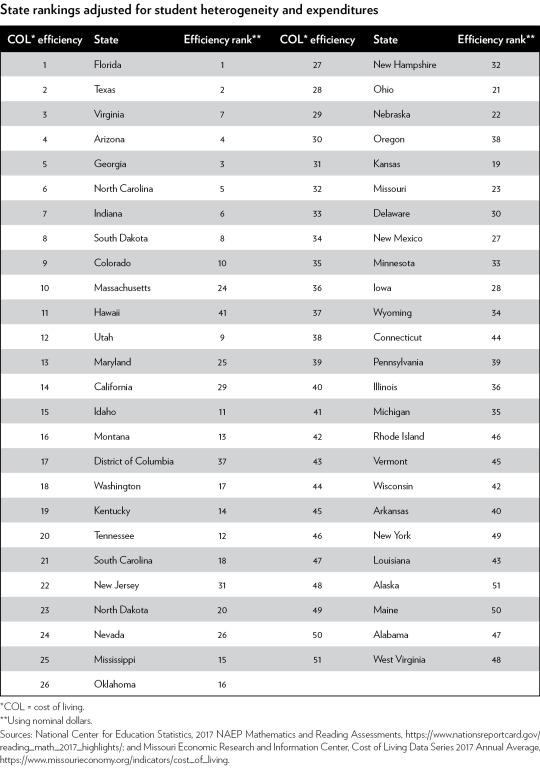
While the authors observe a positive relationship between spending and achievement using nominal dollars, it disappears when state-level cost of living adjustments are made. This does not necessarily imply that spending overall has no effect on outcome, but merely that most states have reached a sufficient level of spending such that additional spending does not appear to be related to achievement as measured by these test scores.
The authors also briefly examine additional factors that affect student performance. They find states with stronger unions tend to get worse academic outcomes. Unions are negatively related to student performance, presumably through opposing the removal of underperforming teachers, opposing merit-based pay, or because of union work rules. Additionally, the authors’ results indicate that having a greater share of students in charter schools is positively related to student achievement.
Although this study constitutes a significant improvement on leading state education rankings, it retains some limitations. There exists substantial variation in education quality within states and disagreement about desired educational outcomes. However, state-level rankings do provide an intuitively pleasing basis for lawmakers and interested citizens to compare state education policies. The authors’ main goal is to provide rankings that more accurately reflect the learning that is taking place by focusing only on academic achievement and disaggregating scores, rather than scoring inputs and state-wide test scores.

Transit Ridership Is Declining:
Since 2014, ridership has been steadily falling in almost every urban area despite a healthy economy.
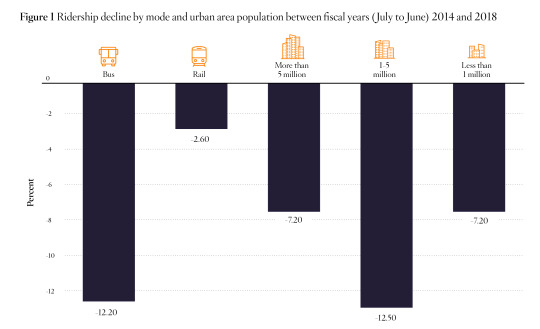
Transit’s Recent Decline Is Nearly Catastrophic in Some Areas:

Transit ridership in 31 of the nation’s 50 largest urban areas has dropped 15 percent or more since the year of highest ridership in each region in the last decade. While transit ridership has declined in the past, as it did between 1990 and 1995, it recovered due to high gas prices. Today, moderate gas prices are fueled by America’s resurging oil industry, and when that resurgence is combined with deteriorating transit infrastructure and the growth of the ride-hailing industry, it appears that the most recent decline may be irreversible.
Transit Requires High Downtown Job Concentrations:
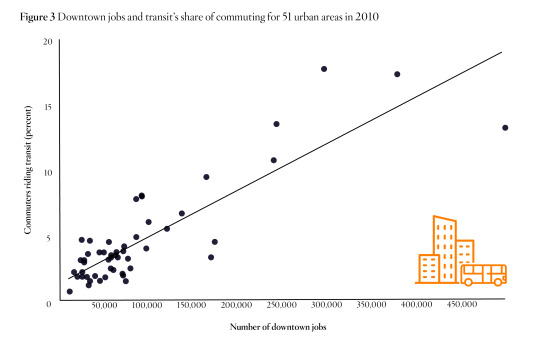
Many assume that transit ridership is heavily influenced by population density, however, much more important to transit is the concentration of downtown jobs. A major reason for transit’s decline has been the dispersion of jobs from concentrated job centers to distribution across the urban landscape. O'Toole finds the only urban areas whose transit systems carried more than 10 percent of commuters had more than 240,000 downtown jobs.
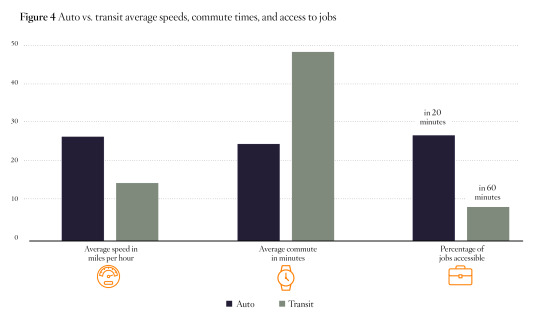
The average speed of transit is 15 miles per hour while the average speed of urban driving is at least 27 miles per hour.
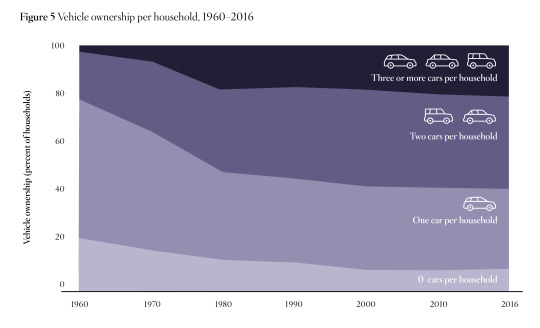
Americans have responded to the automobile’s advantages over transit by steadily increasing automobile ownership, with 21 percent of American households having three or more cars and fewer than 9 percent having no car. Making matters even more difficult for transit, about half the households with no cars also have no workers: only 4.3 percent of American workers live in households that have no cars. In addition, more than 20 percent of workers in carless households nevertheless drive alone to work (probably in employer-supplied cars) while fewer than 42 percent take transit to work.

Per passenger mile, transit costs more than four times as much as driving, and transit subsidies are more than 70 times larger than highway subsidies.
About Half the Cost of Transit Is Because It Is Government-Run:
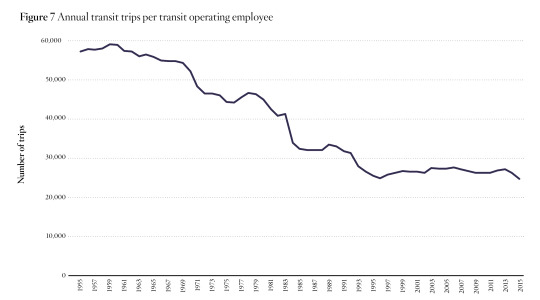
Today transit carries fewer than 27,000 riders per operating employee compared to 59,000 riders per employee in the decade prior to 1964, the year Congress gave cities and states incentives to municipalize transit systems.
Since 1970, Subsidies Have Exceeded $1.3 Trillion:
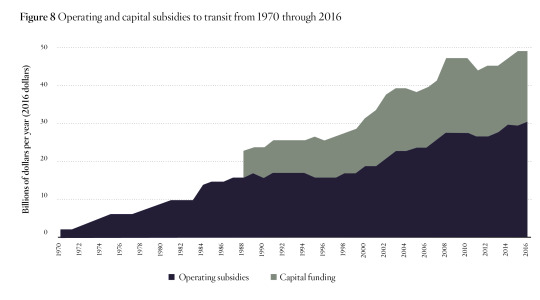
Current total transit subsidies total more than $50 billion a year, with annual subsidies averaging more than $150 per U.S. resident even though most people rarely, if ever, use transit. A major problem with transit agencies’ dependence on subsidies is that such dependence makes them more beholden to politicians and their backers than to transit riders. Agencies become willing and eager to approve cushy union contracts and gold-plated infrastructure projects that do little to improve local or regional transportation. Meanwhile, politicians neglect the maintenance of existing systems, leading to frequent breakdowns.
Growing Subsidies Haven’t Boosted Transit Ridership:
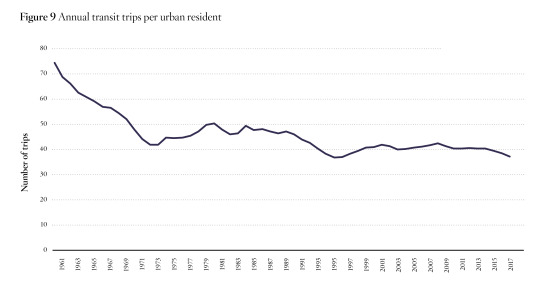
At best, the tens of billions of dollars in annual transit subsidies have only slowed the decline in ridership.
Transit Is Increasingly Used By High-Income People:
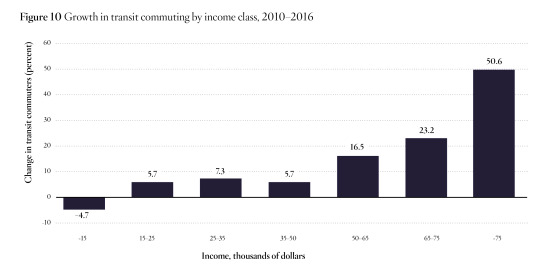
The 2010 Census found that people who earned $75,000 or more per year were more likely to ride transit than any other income class.

In all but four urban areas, transit uses more energy and emits more greenhouse gases per passenger mile than driving.
Transit Spending Doesn’t Boost Urban Growth:

The fastest-growing urban areas in the 2000s were ones that spent the least on transit improvements in the 1990s, while urban areas that spent the most on transit improvements were among the slowest-growing regions.

A multilateral solution harnessing the World Trade Organization’s (WTO) dispute settlement system is the better solution.
While some of China’s specific practices may be a problem, its desire for economic development is natural and appropriate. Demonizing China for participating in trade practices which are common in other countries exacerbates the problem. Whatever policies are adopted with respect to Chinese trade should not try to limit China’s economic ambitions.
When practices do arise that are protectionist or otherwise problematic, the U.S. along with its key allies should utilize internationally agreed upon trade rules to steer China toward market-oriented solutions. Despite the belief that China “cheats” at trade and therefore litigating through the WTO would be worthless, China actually has a relatively strong record of compliance. Of the matters litigated against China since it joined the WTO, 12 were litigated all the way through, while 10 were either addressed in settlements or dropped. In almost all of these completed cases, China’s response was to move toward greater market access by altering its measures and practices to comply with WTO rules.
While this litigation has been successful, there are several possible WTO complaints that have been overlooked, including those involving general intellectual property protection and enforcement, trade secrets protection, forced technology transfer, and subsidies. One glaring example is the U.S. failure to pursue broad WTO complaints targeting China’s transgressions against U.S. intellectual property rights.
The existing WTO rules are not adequate in all respects to deal with the unique challenges presented by China. The remedy for this inadequacy is not, however, abandoning those rules, but the adoption of more and better ones. China’s protectionist policies should encourage countries to redouble their efforts to reinvigorate the rules-based trading system by negotiating new rules to discipline protectionist actions and encourage China to adopt market-based approaches. These new rules could include Chinese accession to the WTO’s Government Procurement Agreement, negotiation of new disciplines on subsidies for state-owned enterprises, and negotiation of disciplines on forced localization of services and other aspects of digital trade and digital trade in services, to name a few.
The Trump administration may prefer the contentious use of unilateral tariffs, but if they are looking for effective approaches to addressing Chinese protectionism, WTO disputes are the better avenue.
The WTO dispute process is not perfect but, it’s biggest flaw is that it is underutilized. The Trump administration should work with U.S. allies to use the WTO dispute process to press China to fulfill its promises and become more market-oriented.

Many have argued that banning or restricting use of cash will reduce criminal transactions within the underground economy. However, just how much underground economic activity constitutes truly harmful criminal acts, as opposed to productive activities that evade taxes or other regulations but nonetheless increase social welfare, is unclear. Further, the likely effects of a cash ban on genuinely predatory activities such as extortion, human trafficking, drug-related violence, and terrorism are extremely difficult to quantify.
Economist Friedrich Schneider estimated that even a complete phasing out of cash would only shrink the underground economy by 10-20 percent. Yet high-denomination bills still account for a substantial volume of licit transactions, so even a ban limited to such high-denomination bills could harm many innocent persons.
Phasing out cash would have a particularly negative effect on the unbanked, including many poor and vulnerable persons, who might find themselves still further excluded from the modern economy. Anti-cash advocates who recognize this admit that any plan to phase out use of cash would have to include corresponding efforts to provide such persons with basic debit cards, if not with smartphones, at a cost that one estimate puts at $32 billion. Phasing out cash would particularly affect illegal immigrants, drastically cutting their labor contributions and creating additional deadweight loss for the U.S. economy. Internationally, a ban on cash would harm those who use U.S. dollars as a refuge for value, sheltering their savings from the influences of unstable currencies and corrupt governments.
Advocates of phasing out currency also see it as a means of allowing monetary authorities to implement negative interest rate policies. Negative rates could then be imposed on all money holders, acting as a direct tax on their money monetary balances. The necessity of this tool is questionable at best – there are only three instances in the past quarter century where negative interest rates could possibly have been helpful, hardly meriting the extreme measure of eliminating cash. Negative interest rates in a cashless economy end up giving an unelected regulatory body discretionary power to tax money and would require massive restructuring of financial institutions and norms.
Finally,most arguments for doing away with cash ignore the public-choice dynamics of the myriad regulations that such a reform would require. Even if banning cash produced benefits such as a reduction in crime, do those benefits offset the harms and costs to those who use cash for legitimate reasons? Consideration should be given to alternative means for preventing crime and tax evasion that do not cast their web so widely.
In short, none of the arguments favoring restrictions on cash withstand close scrutiny.
It is the advocates of restricting hand-to-hand currency who bear the burden of proof for such an extensive reshaping of the monetary system, no matter how cautiously or slowly implemented and no matter whether all cash is eliminated or just large-denomination notes.

A split Congress could affect President Trump’s negotiating strategy vis-à-vis North Korea, but the legislative branch’s impact will mostly come at the margins of U.S. policy.
Trump’s control over the two major levers of U.S. pressure on North Korea —sanctions implementation and the military — means that he has significant discretion over negotiations with Pyongyang. By controlling the sources of U.S. pressure, Trump can adjust either and impact negotiations with little concern for what Congress thinks or wants.
Congress does have the ability to prevent either extreme outcome of war or peace, but neither of these seem likely given the current conditions on the peninsula.
The ACA’s pre-existing condition regulations lose support when the public learns the cost…

Democrats pinned much of their hopes this election season on protecting Americans from pre-existing conditions from losing certain coverage mandates. In fact, about half of Democratic ads featured health care issues compared to less than a third of Republican ads.
Much of the public debate centered on pre-existing condition protections assume that these regulations enjoy widespread public support.
Days before the 2018 midterms, 68% of voters said that health care is very or extremely important to how they plan to vote in this year’s elections, according to a new Cato 2018 Health Care Survey of 2,498 Americans.
However, the survey also finds that public support for pre-existing condition regulation plummets to less than half in favor when Americans are faced with the likely trade-offs and costs of these regulations, which goes against the widespread perception among the political punditry that pre-existing condition regulations are necessarily and universally supported by voters across the political spectrum.
Learn more…
Could the midterm elections spell good news for much-needed immigration reform?

In this election, journalists following the immigration beat will focus on the outcomes of individual races. Dave Brat, the Virginia nativist whose defeat of House Majority Leader Eric Cantor in 2014 doomed hopes of immigration reform, lost in a previously safe GOP seat. Democrats blew out Corey Stewart in Virginia and Lou Barletta in Pennsylvania, the most anti-immigrant Senate candidates. Kris Kobach, the author of state anti-immigrant laws across the country, cost Republicans the governorship in Kansas.
But, when it comes to immigration, the two most important outcomes of this election are in the big picture.
First,nativists have officially squandered their last, best chance to restrict legal immigration. There may never be another moment like the one in 2017 and 2018, where the House, Senate, and White House were all controlled by Republicans with nativist agendas. They held multiple votes in the House and Senate on various measures to make legal immigration cuts, and all their efforts went down in flames.
The second outcome is even more important: the House of Representatives is now the most pro-immigrant that it has been since the 19th century. Current House Democrats would not only pass the broadest legalization in the history of the United States — they also would greatly expand legal immigration. No elected House Democrat is opposed to legalization, even if they would want it paired with some enforcement measures.
Better yet, this House will have the backing of the most pro-immigration general public in recorded history. More Americans oppose cuts to immigration and favor expanded immigration than at any point since at least 1965.

President Trump has announced that he plans an executive order that would remove the right to citizenship for babies of noncitizens and unauthorized immigrants born on U.S. soil.
The 14th Amendment became part of the U.S. Constitution 150 years ago in July of 1868. Among other things, it enshrined our traditional common law practice of granting citizenship to those born in the United States who are subject to its laws-specifically it guaranteed that the recently freed slaves and their descendants would be citizens. The 14th Amendment also applied to the children of immigrants, as its authors and opponents understood at the time.
Released earlier this year, President Trump’s immigration position paper, however, famously endorsed an end to birthright citizenship. Michael Anton, a former national security official in the Trump administration as well as a lecturer and researcher at Hillsdale College, has argued that President Trump should use his pen and his phone to exclude the children born here to noncitizens, with little thought of what would happen were such a policy enacted.
Taking Anton’s advice would do grievous harm to our country, destroy one of the finest legacies of the Republican Party, and overturn centuries of Anglo-American common law in exchange for a citizenship system that would slow assimilation.
In addition to being constitutionally questionable, such an order would harm all Americans, not just the children or grandchildren of noncitizens.
Birthright citizenship is good for the United States. It guarantees that everyone who is born in America believes that they are Americans, which is the single best policy for promoting assimilation.

During his campaign, Donald Trump vowed to aggressively ramp up immigration enforcement by implementing “extreme vetting,” building a wall along the southern border, cracking down on so-called “sanctuary cities,” and creating a “deportation force.” President Trump and his allies took steps to implement some of these proposals shortly after his inauguration. There are ample reasons for concern over how such efforts will impact America’s law enforcement agencies and Americans’ civil liberties.
In order to be effective, the president’s proposals require the federal government to gather more information about American citizens. Border Patrol will increase its presence both at the border and at interior checkpoints, inconveniencing Americans and foreigners alike. Immigration law enforcement officials will exploit the lack of privacy protections at the border, leading to citizens being pressured into providing authorities with access to their electronic devices. The federal government will increase surveillance and explore new tools, such as facial-recognition drones. Federal immigration officials will expand databases and include biometric information on both visitors and American citizens.
Although the president could take steps to reverse many of the damaging features of his immigration policy, such a reversal is unlikely. However, policymakers can mitigate the risks of the immigration agenda by strengthening legal protections on the border and limiting federal involvement in state and local policing.
There’s been a lot of talk about impeachment lately. What role will it play in the midterm elections?
LISTEN TO THE FULL PODCAST: http://j.mp/2D5yOwF

The story of state occupational licensing is the same across most occupations. Insiders want to block outsiders — people they deem less professional — from practicing their occupation. Thus, they lobby state legislators or licensing boards to restrict entry into the occupation.
Licensing advocates will typically argue that requiring a state license is necessary to guarantee quality or to protect public health and safety from unprofessional or dangerous workers. However, advocates lobby vigorously to protect their turf by creating barriers to entry with scant evidence that those barriers will improve quality, public health, or public safety. Once an occupation is licensed, workers are motivated to increase the costs to outsiders by changing requirements to include more hours of education, higher grades to pass exams, or increased fees.
Unlicensed workers operating in the shadow (or informal) economy have a harder time standing up to such threats. Those workers will earn less than they could out in the open. Hiring employees and paying taxes might expose them as unlicensed operators.
Licensing harms consumers by increasing the price of services and decreasing innovation — without ensuring quality. Consumers may purchase fewer services. Consumers who choose to save money by hiring unlicensed practitioners may face fewer legal protections. And people who chose to save money by performing potentially dangerous work themselves, like electrical work, place themselves at a greater risk of harm.
On top of those tradeoffs, consumers still face the costs of finding reputable service providers, despite claims that occupational licensing establishes professionalism and quality. Remember experiences you may have had with a bad haircut, a slow home contractor, an angry nurse, or a painful dental procedure.
Licensing is not a substitute for reputation. Word of mouth is a typical method for finding quality service providers, even in licensed occupations. Today it is easier than ever to find a provider who will best fit your needs. Technology reduces search costs through website reviews from Yelp, Angie’s List, and TripAdvisor, for example, and through crowdsourcing on sites like Facebook and Reddit.
In addition to failing to ensure quality, there is little to no evidence that occupational licensing improves health and safety outcomes for consumers. And consumers do not require occupational licenses to feel safe.
Passed in 1920, the Jones Act was meant to ensure a strong U.S. merchant marine. But the law has failed to prevent the U.S. maritime industry’s steady downward spiral, all while imposing significant economic costs.
The Cato Institute is shining a spotlight on the Jones Act’s myriad negative impacts and exposing its alleged benefits as entirely hollow. By systematically laying bare the truth about this nearly 100-year-old failed law, the Cato Institute Project on Jones Act Reform is meant to raise public awareness and lay the groundwork for its repeal or reform.

The apparent abduction, and probable murder, of the prominent Saudi journalist Jamal Khashoggi at the Saudi consulate in Istanbul on Oct. 2 unmasked the ugly despotism behind the reformist image of the kingdom’s crown prince, Mohammed bin Salman.
Less noticed, however, is the way this scandal revealed a long-running rivalry between the two countries that directly butted heads at the outset: Turkey and Saudi Arabia.
This is a story that goes back to the 18th century. Then, much of what we call “the Middle East” today, including the more habitable part of the Arabian Peninsula, was part of the Ottoman Empire, ruled from Istanbul, then called Constantinople, by a cosmopolitan elite of mainly Turks and Balkan Muslims, including Bosnians and Albanians. The Hejaz, the western region of the Arabian Peninsula that included the holy cities of Mecca and Medina, was revered for religious reasons, but it was a backwater with no political or cultural significance.
In the 1740s, in the most isolated central area of the Arabian Peninsula, called Najd, a scholar named Muhammad ibn Abd al-Wahhab emerged with a fiery call for the restoration of “true Islam.” Wahhab soon allied with a chieftain called Ibn Saud—the founder of the Saudi dynasty.
The First Saudi State they established together grew in size and ambition, leading to a big massacre of Shiites in Karbala in 1801 and the occupation of Mecca in 1803. The Ottomans crushed the Wahhabi revolt in 1812 via their protectorate in Egypt, and Wahhabism retreated to the desert.
Another tumult in Hejaz occurred in 1856 when the Ottomans, thanks to the influence of their British allies, introduced another heretical “innovation”: the banning of slave trade, which was then a lucrative business between the Africa coast and the Arabian city of Jeddah. At the behest of angry slave traders, Grand Sharif Abd al-Muttalib of Mecca declared that Turks had become infidels and their blood was licit. As we learn from the chronicles of Ottoman statesman Ahmed Cevdet Pasha, Turks’ sins included “allowing women to uncover their bodies, to stay separate from their fathers or husbands, and to have the right to divorce.”
These were the changes introduced during the Tanzimat, the great Ottoman reform movement in the mid-19th century by which the empire imported many Western institutions and norms. The Tanzimat allowed the Ottoman Empire to ultimately become a constitutional monarchy with an elected parliament—something still unimaginable in the absolute monarchy of Saudi Arabia. It also allowed the rise of the modern Turkish Republic, where secular law became the norm, women gained equal rights, and democracy began to grow.
Today, admittedly, Turkey became the home of jailed journalists, crushed opponents, hate, paranoia, and a new cult of personality that has been called “Erdoganism.” Yet Erdogan and his fellow Islamists are still Turkey’s Islamists—that is, compared with Saudi Arabia’s elites, they are still operating within a more modern framework that reflects a milder interpretation of Sunni Islam.
Indian prime minister Narendra Modi has been hailed as an economic liberalizer, but new import duties on more than 40 items threaten to reverse the major gains India has made since economic reforms began in 1991…

When Indian prime minister Narendra Modi came to power in 2014, he was seen as a liberalizer, bearing the slogan, “Minimum government, maximum governance.” He has since sharply criticized rising U.S. protectionism under the Trump administration.
In reality, Modi has expanded the role of government in welfare even while liberalizing the economy incrementally. Most recently, just like President Trump has done in the United States, Modi has promoted measures to protect and support manufacturing jobs in India.
The latest Indian budget — from February 2018 — raised import duties on more than 40 items, ranging from auto parts and toys to candles and furniture, in order to protect uncompetitive small businesses and create jobs in labor-intensive industries. Even before that, India raised import duties on several electronic items, from phone components to TVs and microwave ovens — all done in pursuance of a Phased Manufacturing Program aiming to check massive imports from China and ensure that cellphone assembly and the manufacture of components are done mostly in India. An official task force has also been appointed to look into ways of reducing import dependence.
Modi’s Bharatiya Janata Party (BJP) is not a conventional right-wing party. It rejects both socialism and Western capitalism and seeks a homegrown solution called Integral Humanism. It supports private enterprise but also runs India’s biggest trade union and believes in a wide-ranging welfare state. It has highly protectionist affiliates that have always been wary of multinational corporations and international institutions. It believes in government intervention to create national champions, increase employment, and protect small businesses. The party also contains many liberalizers who succeeded in opening up the economy when the party ruled from 1998 to 2004, overcoming objections from BJP affiliates.
Modi now faces the same global headwinds that Trump does: fear of China, automation, and lack of good jobs. These pressures are driving India’s new protectionism, just as they have done in the United States. Optimists hope the new import tariffs are only temporary. The risk is that the new protectionism will get entrenched and reverse the major gains India has made since economic reforms began in 1991.
In the War on Drugs, patients and doctors are often the mistaken targets in the fight against the so-called opioid epidemic.
Study after study show a “misuse” rate of less than 1% in patients prescribed opioids for acute pain or chronic pain. And numerous large studies show an even lower overdose rate from opioids used in the medical setting.
Fear of opioids propels drug prohibition, the black market, and rising overdoses from heroin and fentanyl. It also drives the misguided prohibition on prescribing pain medication, causing patients to suffer and destroying lives.
Learn more, and join the conversation on Twitter with #CatoDrugWar…
Policymakers in every state should adopt the fiscal approaches of this year’s top-scoring governors…

Today, the Cato Institute released its biennial Fiscal Policy Report Card on America’s Governors, produced by Chris Edwards, director of tax policy studies and editor of www.DownsizingGovernment.org.The report uses statistical data to grade the governors on their taxing and spending records from a limited-government perspective.
Five governors received the highest grade of “A”: Susana Martinez of New Mexico, Henry McMaster of South Carolina, Doug Burgum of North Dakota, Paul LePage of Maine, andGreg Abbott of Texas.
Eight governors received the lowest grade of “F”: Roy Cooper of North Carolina, John Bel Edwards of Louisiana, Tom Wolf of Pennsylvania, Jim Justice of West Virginia, David Ige of Hawaii, Dennis Daugaard of South Dakota, Kate Brown of Oregon, and Jay Insleeof Washington.

The report card looks at data since 2016 for each state and awards an objective grade based on spending variables, a revenue variable, and tax rate variables. Governors who have cut taxes and spending the most receive the highest grades, while those who have increased taxes and spending the most receive the lowest grades.
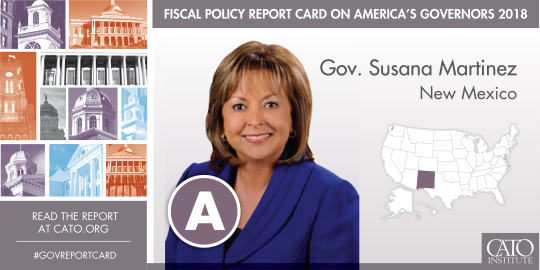
Susana Martinez receives the highest score in this year’s report due to her spending restraint, tax cuts, and steadfast opposition to tax increases. New Mexico’s budget has remained roughly flat in recent years, and Martinez has repeatedly vetoed wasteful spending. She has pursued reforms to make New Mexico more competitive, including cutting the corporate tax rate. With revenues from energy production stagnant in recent years, balancing New Mexico’s budget has been a challenge. But Martinez has held firm against tax increases proposed by the legislature, including vetoing $350 million worth of tax increases last year.

Jay Inslee is the worst-scoring governor this year. The report argues that his “appetite for tax and spending increases has been insatiable.” Though he originally campaigned on a promise not to raise taxes, Inslee has pushed many hikes over the years, including increases in business taxes, capital gains taxes, cigarette taxes, sales taxes, and a huge new carbon tax. Inslee has also been spendthrift— the current biennial budget in Washington state is up 17 percent over the prior budget.
In this year’s report, Edwards discusseshow the federal Tax Cuts and Jobs Act of 2017 is affecting state fiscal environments. He also examines revenues from marijuana legalizationandrecent Supreme Court decisions on online sales taxes and public-sector labor unions.
Edwards notes, “The 2017 federal tax act has ushered in a new era of state tax competition. Governors need to lead efforts to deliver better services at lower costs, else risk losing residents to other states. Policymakers in every state should adopt the fiscal approaches of this year’s top-scoring governors.”
Read the report, then join the conversation on Twitter with #GovReportCard…

The degree and speed at which immigrant wages converge with the wages of native-born Americans are important indicators of economic assimilation.
According to new research from Cato scholars, newly arrived immigrants have wages lower than otherwise identical natives, but those wage differences diminish greatly or disappear entirely after about two decades of working in the United States.
Over time, the wages of immigrants converge with those of similar U.S.-born Americans. While illegal immigrants never close that gap, providing these workers with legal status would allow them to demand the same wages as similar American workers.
The fact that immigrants tend to achieve the same or greater levels of economic prosperity in the United States shows that the American Dream is still alive and that America’s overly generous welfare state has not stopped immigrants from assimilating into America’s economy.

Paid parental leave provides workers with financial compensation during temporary absences following the birth or adoption of a child. Private companies often provide paid leave and the federal government mandates 12 weeks of job-protected unpaid leave, but recently policymakers and advocates have become dissatisfied with the status quo.
Proponents of federal intervention argue that the private market does not or cannot provide sufficient paid leave. Moreover, proponents believe government supported leave would improve labor market outcomes and reduce gender and labor-market inequality.
However, the evidence that suggests otherwise…
First, ample data show that the private market provides paid leave at rates about 30 to 50 percentage points higher than proponents claim. Private paid leave provision has grown three- or fourfold over 50 years and continues to grow. This trend indicates industry is responsive to employee demands.
Second,workers may not be better off under federal paid leave and may be worse off. Government intervention provides new incentives, and individuals are likely to adapt accordingly. Evidence suggests government supported leave may result in wage or benefit reductions, female unemployment, or reduced professional opportunities for women.
Government intervention is also unlikely to correct gender or labor-market inequality in ways proponents desire. For example, families may respond to the policy by increasing women’s household work contributions relative to men’s. Redistributive effects of government intervention are likely to harm workers.
Policymakers should not adopt paid parental leave policies. Instead, they should consider improving workers’ lives through reforms that increase economic efficiency, remove barriers to flexible work, and increase choice.

TheEconomic Freedom of the World — an annual report, co-published by the Cato Institute, the Canada-based Fraser Institute, and the Economic Freedom Network, a group of independent research and educational institutes in nearly 100 nations and territories worldwide — seeks to measure the consistency of the institutions and policies of various countries with voluntary exchange and the other dimensions of economic freedom.
Based on data from 2016 (the most recent year for which comparable data is available), the report is the world’s premier measurement of economic freedom, using 42 distinct variables to create an index ranking countries around the world based on policies that encourage economic freedom.
Economic freedom is measured in five different areas: (1) size of government, (2) legal system and property rights, (3) access to sound money, (4) freedom to trade internationally, and (5) regulation of credit, labor, and business.
Each country is rated on a 0-10 scale where a higher value indicates a higher level of economic freedom.
The United States returned to the top 10 with the 6th freest economy after an absence of several years, with an overall rating of 8.03, according to the 2018 Index.
“The increase in the United States’ economic freedom score is welcome, but it remains notably below the level it enjoyed at the beginning of this century,” said Ian Vasquez, director of the Center for Global Liberty and Prosperity at the Cato Institute.
During the 2009-2016 term of President Obama, the U.S. score initially continued to decline as it had under President Bush. From 2013 to 2016, however, the U.S. increased its rating from 7.74 to its current standing. This is still well below the high-water mark of 8.62 in 2000 at the end of the Clinton presidency.
Hong Kong and Singapore occupy the top two positions. The next highest scoring nations are New Zealand, Switzerland, Ireland, United States, Georgia, Mauritius, United Kingdom, Australia and Canada, the last two tied for 10th place. Venezuela is again ranked as the lowest in economic freedom out of the countries of this year’s report.
The rankings of some other major countries are Germany (20th), Japan (41st), Italy (54th), France (57th), Mexico (82nd), Russia (87th), India (96th), China (108th), and Brazil (144th).
Three new countries — Belarus, Iraq, and Sudan — were added to the Index this year, bringing the total number of jurisdictions measured to 162. The Index also integrates differential legal treatment according to gender, thus taking into account the fact that women do not have the same level of economic freedom as men do in all nations.
”Women benefit from greater economic freedom as there is greater gender equality in countries that are more economically free,“ continued Vasquez.
The cornerstones of economic freedom include personal choice, voluntary exchange, freedom to enter markets and compete, and security of the person and privately owned property. The data shows people living in countries with high levels of economic freedom enjoy greater prosperity, more political and civil liberties, and longer life spans.
Nations in the top quartile of economic freedom had an average per capita GDP of US $40,376 in 2016, compared to $5,649 for bottom quartile nations. Moreover, the average income of the poorest 10% in the most economically free nations is almost twice the average per capita income in the least free nations. Life expectancy is 79.5 years in the top quartile compared to 64.4 years in the bottom quartile, and happiness levels are much higher in economically free nations than in unfree nations.

The American Library Association is the primary champion of Banned Books Week, and the group’s website spells out why we are supposed to be outraged. “Banned Books Week is the national book community’s annual celebration of the freedom to read,” it says. The week’s goal is to “draw attention to the problem of censorship by mounting displays of challenged books and hosting a variety of events.”
Basically, we’re supposed to be incensed over people who say “I don’t think anyone should read that,” and then try to destroy the offending books Fahrenheit 451 style. The thing is, for the most part such outright censorship efforts don’t exist. No, most challenges are from parents or taxpayers who don’t want their kids reading or accessing material in public schools that they find offensive, or don’t want objectionable books in the libraries for which they must pay.
The real issue isn’t protecting books from those who would banish them for eternity. It is that public institutions select books in the first place. The instant such a selection is made freedom is already compromised.

